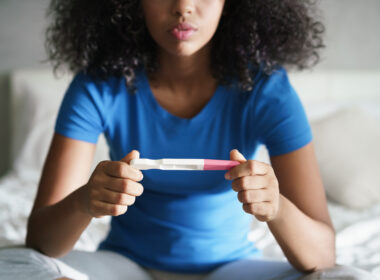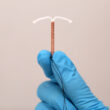As an undergraduate, I once spent an entire summer dissecting fruit fly ovaries (and you thought fruit flies were small!). The reason? I was part of a research team that was investigating how cells migrate, and collecting fruit fly ovaries to study is an efficient research method that only costs the sanity of one or two college students. We know that cells move from place to place, like in cancer, growth, or wound repair, but “how?” was a question we had no answer to at the time.
Similarly to my cellular migration study, we know that hormonal birth control (HBC) is associated with negative mental health effects, but understanding “how?” is a question we are only beginning to understand. A 2022 article from the journal Frontiers in Neuroendocrinology reviews three potential models for how HBC may affect the brain and highlights areas where more research is needed [1].
Three models for how hormonal birth control may impact the brain
#1 Too much of a good thing (hypergonadal state)
The first model for how HBC might affect the brain assumes that the brain responds similarly to the body’s endogenous (i.e., natural) hormones and HBC’s synthetic hormones. It also assumes that keeping these hormonal levels elevated most of the time (as HBC does), instead of a few days of elevation each month (as the natural menstrual cycle does), overexposes the brain to these hormones.
While the Frontiers article expressly states that “estrogens and progestogens play an essential role in basic cognition, brain health, and mental illness etiology,” HBC use eliminates the “yin and yang” relationship between endogenous estrogen and progesterone that many bodily systems rely on. Rather than the body undergoing an estrogen peak, followed by a progesterone peak accompanied with a small estrogen rise (as it does during a typical menstrual cycle), the body under the influence of HBC is “stuck” in an ongoing, artificial “luteal phase,” with high progesterone and typically some estradiol.
#2 Store-bought doesn’t cut it (hypogonadal state)
The second model for how HBC might affect the brain assumes that the brain does not respond similarly to synthetic hormones as endogenous ones. In this model, since synthetic hormones suppress their naturally-occurring counterparts, this would underexpose the brain to these vital compounds. We do know that other synthetic hormones, such as Pitocin, deprive women of some of the benefits we normally see from their endogenous counterparts.
#3 It’s complicated (mixed-state)
This third and final model for how HBC might affect the brain assumes that the answer may involve both hypergonadal traits and hypogonadal traits. This model factors in many of the things we don’t know about HBC, such as how its metabolites (i.e., what it breaks down into) affect the brain and other hormones involved in brain function, and the effects of individual genetic factors.
The verdict?
In evaluating different studies against these three models, the Frontiers article identified that both the luteal phase of the menstrual cycle and HBC use led to increased prefrontal cortex connectivity and decreased parietal lobe connectivity. This would suggest that model #1 (hypergonadal, i.e., “too much of a good thing”) is the most likely, though the authors stress that much more research is needed to confirm this hypothesis.
How are brain connectivity changes tied to anxiety?
The prefrontal cortex is the area of the brain associated with executive skills, that is, decision making, concentration, and planning, amongst other functions. The parietal lobe helps you to place yourself in the world around you: this includes spatial awareness and selecting which environmental stimuli require your attention. The Frontiers article doesn’t speculate on the mental or emotional effects of these brain connectivity changes, but we can make some educated guesses, specifically in regards to anxiety.
A 2007 article on the prefrontal cortex published in the journal Reviews in the Neurosciences mentions that as the prefrontal cortex involves planning, an overactive prefrontal cortex can turn planning into frequent worrying [2]. Decreased parietal lobe connectivity could potentially also contribute to anxiety; we know that coping strategies like the “333 rule” work by utilizing grounding techniques that help reconnect you to your body and environment.
There is also a connection between increased progesterone and anxiety. A 2018 study found that women self-reported higher attachment anxiety during the luteal phase, when progesterone was highest [3]. Rather than this progesterone peak lasting several days in a normal cycle, (synthetic) progesterone is elevated the majority of the time with HBC use.
Why the connection between HBC and anxiety is complicated
While these various studies indicate that there may be a physical, neurological component to why some women experience anxiety while taking HBC, not all women experience anxiety while on birth control. Furthermore, some women experience other mental health symptoms such as depression, indicating that individual factors like genetics and environment are also important to consider.
There’s so much we don’t know about how HBC affects the brain…
Besides summing up the three models and the current research, the Frontiers article authors describe current limitations to understanding the connection between HBC and the brain. There is still a lot to learn about how hormones and neurotransmitters naturally interact. Different research teams also use different methods, which makes comparing studies difficult at this stage. There are also many different forms of HBC on the market, with different formulas, dosages, and routes of administration that may change how these drugs affect the body. Other factors may include whether a person uses HBC for a long or short amount of time, and at what age they start using it.
The Frontiers article also points out that people who have negative mental health effects from birth control are more likely to stop using HBC, eliminating the people who are most affected by HBC from relevant studies. All of this is in addition to the fact that neuroendocrinology is still an emerging field, with many frontiers left to explore.
…but we do know fertility awareness could help us learn more
Another issue mentioned is the difficulty of determining which phase of her cycle a woman is in. Concerningly, all five studies analyzed in the Frontiers article listed “calendar” for their “cycle phase determination method.” While some studies also used hormone tests to better determine cycle phase, the rhythm method or calendar method is not a modern, evidence-based fertility awareness method (FAM), and its use poses serious limitations to determining actual cycle phase. Imagine how data collection could improve if results could be compared against carefully-tracked menstrual cycle biomarkers via a FAM! When we know we’re accurately identifying menstrual cycle phases, we can be more confident we’re making apples-to-apples comparisons about the effects of natural vs synthetic hormones on the brain. We’re anxious (yes, pun intended!) for this to happen!
Additional Reading:
What does birth control do to women’s ability to process fear?
Your hormones during a natural cycle vs. your hormones on the Pill
References:
[1] Casto KV, Jordan T, Petersen N. Hormone-based models for comparing menstrual cycle and hormonal contraceptive effects on human resting-state functional connectivity. Front Neuroendocrinol. 2022 Oct;67:101036. doi: 10.1016/j.yfrne.2022.101036. Epub 2022 Sep 17. PMID: 36126748; PMCID: PMC9649880. [2] Berkowitz RL, Coplan JD, Reddy DP, Gorman JM. The human dimension: how the prefrontal cortex modulates the subcortical fear response. Rev Neurosci. 2007;18(3-4):191-207. doi: 10.1515/revneuro.2007.18.3-4.191. PMID: 18019606. [3] Reynolds TA, Makhanova A, Marcinkowska UM, Jasienska G, McNulty JK, Eckel LA, Nikonova L, Maner JK. Progesterone and women’s anxiety across the menstrual cycle. Horm Behav. 2018 Jun;102:34-40. doi: 10.1016/j.yhbeh.2018.04.008. Epub 2018 Apr 24. PMID: 29673619.






